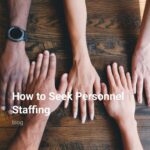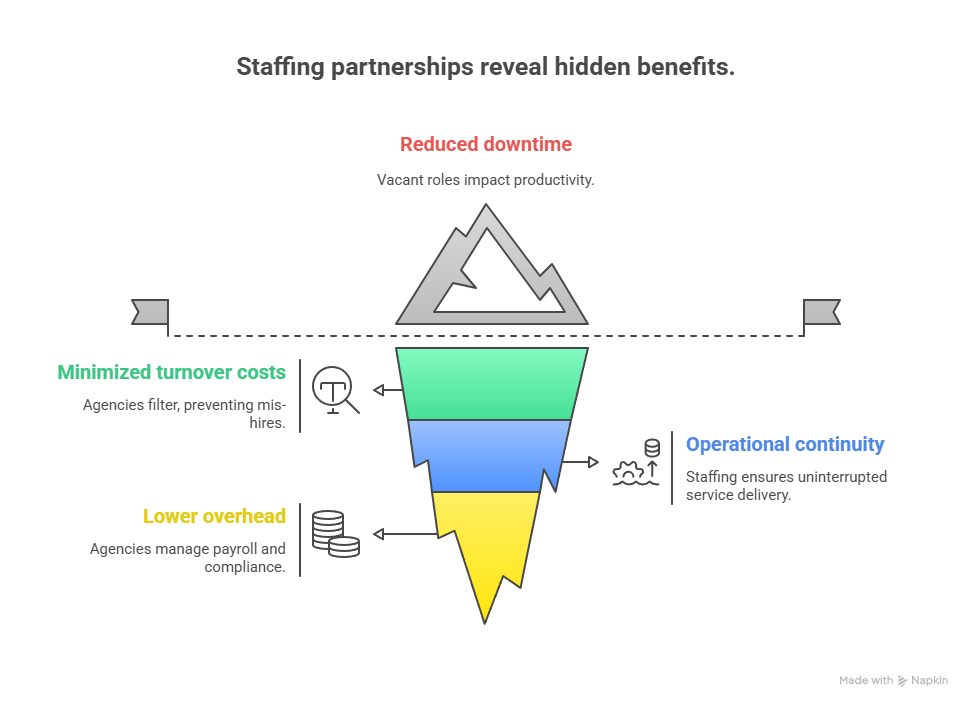
Strategic Workforce Solutions
Every business, regardless of size or industry, relies on people. Finding the right people at the right time, however, is one of the most consistent challenges leaders face. This is why so many companies seek personnel staffing solutions. Staffing agencies play a critical role in connecting employers with qualified talent, reducing hiring risks, and helping candidates find rewarding opportunities.
But staffing isn’t just about filling empty seats. Today’s workforce requires adaptability, specialized knowledge, and careful alignment between employee and employer expectations. Personnel staffing agencies bridge these gaps by providing short-term, long-term, and temp-to-hire solutions tailored to the unique needs of modern businesses.
What Does It Mean to Seek Personnel Staffing?
When a business chooses to seek personnel staffing, it is outsourcing part or all of the recruitment process to an agency. These agencies recruit, screen, and place employees into roles that fit the employer’s needs. Common services include:
- Temporary staffing: Short-term workers brought in for projects, seasonal needs, or sudden workforce shortages.
- Temp-to-hire staffing: Workers start in temporary roles but have the potential to be hired permanently after a trial period.
- Direct hire staffing: Agencies recruit and screen candidates for permanent, full-time roles.
For candidates, this model provides access to opportunities that might not be advertised elsewhere. For employers, it delivers speed, flexibility, and reduced overhead in the hiring process.
Why Businesses Seek Personnel Staffing
1. Speed and Efficiency
Recruiting can take weeks or even months. Background checks, job postings, interviews, and onboarding drain time and resources. Staffing agencies streamline this process by maintaining active pools of pre-screened candidates who can be placed quickly.
2. Workforce Flexibility
Many industries experience seasonal spikes, project-driven demand, or unexpected labor shortages. Personnel staffing agencies provide the ability to scale the workforce up or down without the complications of long-term hiring commitments.
3. Specialized Talent Access
Companies often need workers with specific technical skills, certifications, or industry experience. Staffing agencies specialize in sourcing and vetting these individuals, ensuring the right expertise is available when needed.
4. Reduced Risk
Bad hires are costly. Staffing agencies reduce this risk by managing payroll, benefits, and employment liabilities for temporary workers. In temp-to-hire scenarios, employers can evaluate candidates on the job before committing to permanent employment.
5. Cost Control
The true cost of hiring includes advertising, interviewing, onboarding, and training. Outsourcing to a staffing partner reduces these expenses while ensuring businesses maintain operational continuity.

The Benefits of Personnel Staffing for Job Seekers
It isn’t just businesses that benefit. Workers increasingly seek personnel staffing opportunities as a career path or stepping stone.
- Access to hidden job markets: Many positions are filled exclusively through staffing agencies and never reach job boards.
- Faster job placement: Agencies often have immediate openings, reducing the wait between jobs.
- Skill development: Temporary roles allow workers to gain experience in different industries and environments.
- Temp-to-hire pathways: Candidates can demonstrate their value on the job and secure long-term employment.
- Flexibility: Short-term assignments provide income and stability while accommodating personal schedules or other commitments.
Common Scenarios Where Companies Seek Personnel Staffing
- Seasonal surges – Retailers, manufacturers, and logistics companies often need additional staff during holidays or peak seasons.
- Project-based work – Construction, IT, and healthcare providers frequently bring on temporary staff to complete large projects.
- Strike staffing or labor disruptions – Personnel staffing ensures business continuity during workforce interruptions.
- Unexpected turnover – Agencies quickly provide replacements when critical employees resign.
- Expansion into new markets – Companies moving into new territories can test workforce needs through temporary staffing before committing to full-time hires.
Strategic Value of Seeking Personnel Staffing
Most discussions around staffing agencies focus on the tactical level — filling jobs, meeting quotas, or handling seasonal demand. While these aspects are essential, the real impact of personnel staffing emerges when viewed through a strategic lens. Businesses that seek personnel staffing effectively can use it as a lever for growth, risk management, and organizational resilience.
Workforce Agility as a Competitive Advantage
One of the hallmarks of today’s economy is unpredictability. Markets shift quickly, supply chains fluctuate, and customer demands change overnight. Organizations that can scale their workforce in real time gain a competitive advantage. Staffing partners make this agility possible.
Instead of carrying the financial burden of a bloated payroll during downturns, companies can adjust their workforce fluidly. Conversely, when new opportunities arise — such as a major contract, product launch, or market expansion — a staffing partner ensures the business has the right people in place to execute without delay.
The Hidden ROI of Staffing Partnerships
On paper, staffing services may appear to be an additional expense. In reality, they often generate a return on investment that is difficult to achieve through internal hiring alone. Consider the following dimensions of ROI:
- Reduced downtime: Every vacant role represents lost productivity. Staffing reduces the time-to-fill.
- Minimized turnover costs: Agencies act as a filter, helping prevent costly mis-hires.
- Operational continuity: In industries like healthcare, logistics, and manufacturing, staffing ensures production and service delivery remain uninterrupted.
- Lower overhead: Agencies often manage payroll, benefits, and compliance for temporary employees, allowing companies to focus resources elsewhere.
When leaders evaluate staffing through the lens of risk mitigation and operational continuity — rather than just cost — its value becomes clearer.

Personnel Staffing as a Talent Pipeline
Temp-to-hire models often serve as trial periods for candidates, but advanced organizations use them as long-term talent pipelines. By engaging workers through temporary roles, companies can continuously evaluate fit, skill levels, and cultural alignment. Those who prove themselves move into permanent positions, ensuring the organization is always cultivating its next generation of talent.
This approach also provides workers with real-time experience inside the company before they commit. The result is higher employee satisfaction and longer tenure once they transition into full-time roles.
Staffing in Times of Disruption
Labor shortages, strikes, and economic shocks highlight the importance of staffing strategies. Companies that wait until disruption occurs often scramble to react. Those that proactively build relationships with staffing agencies, however, have contingency plans in place.
For instance:
- Strike staffing ensures business continuity during labor disputes.
- Crisis response staffing helps maintain service when sudden surges or emergencies arise.
- Succession planning can be supported by temporary placements that allow critical roles to remain filled during leadership changes.
In this way, staffing is not just an HR function — it is a risk management tool that protects revenue streams and brand reputation.
The Evolving Candidate Experience
It’s easy to view staffing solely from the employer’s side, but candidates’ expectations are also reshaping the industry. Job seekers increasingly want transparency, flexible opportunities, and clear career pathways. Personnel staffing agencies that can deliver on these expectations gain loyalty from both workers and employers.
Agencies are now integrating technology into their services — mobile onboarding, instant communication, and digital scheduling tools — to create a smoother candidate experience. Employers who partner with these agencies benefit from stronger talent attraction and higher engagement levels.
Building a Multi-Layered Workforce Strategy
High-performing companies don’t view staffing as a stopgap. Instead, they embed it into their broader workforce strategy. This involves three layers:
- Core employees – Permanent staff who carry institutional knowledge and leadership responsibilities.
- Strategic temporary talent – Skilled specialists brought in for targeted projects or during peaks in demand.
- Flexible labor pool – Workers available through staffing agencies for short-term assignments, offering adaptability without long-term commitment.
Balancing these layers allows companies to weather market shifts, pursue growth initiatives, and keep labor costs aligned with actual business activity.
Measuring Success in Personnel Staffing
Advanced organizations don’t just “use” staffing services; they measure and optimize them. Metrics that leaders track include:
- Time-to-fill: How quickly positions are filled compared to internal averages.
- Assignment completion rate: The percentage of temporary workers who complete their assignments successfully.
- Conversion rate: How many temp-to-hire candidates transition into permanent roles.
- Retention rate: The tenure of candidates placed by the staffing agency versus direct hires.
- Cost savings: Calculations of avoided downtime, reduced overtime for permanent staff, and minimized turnover.
By quantifying these outcomes, companies ensure their staffing strategy supports long-term organizational goals.
The Future of Personnel Staffing
Looking ahead, staffing will continue evolving alongside technology and labor market dynamics. Trends shaping the future include:
- AI-driven matching: Algorithms that pair candidates with roles more accurately and quickly.
- Remote staffing solutions: Agencies increasingly provide virtual talent across industries.
- Upskilling partnerships: Agencies may take on training responsibilities to prepare candidates for specialized roles.
- Data transparency: Employers will expect staffing agencies to provide insights on performance, retention, and industry benchmarks.
In this landscape, companies that proactively seek personnel staffing won’t just fill roles — they’ll build adaptable, forward-looking workforce systems.
How to Maximize the Value When You Seek Personnel Staffing
Understanding the strategic role of staffing is only half the equation. To capture the full benefits, employers must know how to approach staffing partnerships with clarity and intention. The following steps serve as a framework for building an effective strategy.
1. Define Your Workforce Needs Clearly
Before engaging with a staffing agency, identify exactly what you need. Consider:
- Skills required – Are you filling general labor positions, specialized technical roles, or leadership gaps?
- Duration of need – Will workers be required short-term, seasonally, or potentially long-term?
- Workload patterns – Do you anticipate surges at specific times of year or around major projects?
- Cultural alignment – What traits define your company culture, and how can staffing candidates reflect them?
The more clarity you provide, the more precise and effective the agency’s placements will be.
2. Choose the Right Staffing Partner
Not all staffing firms are equal. When evaluating agencies, consider:
- Industry expertise: Do they specialize in your sector or serve a broad base of industries?
- Geographic coverage: Can they deliver talent where you operate?
- Screening process: How rigorous are their background checks, interviews, and assessments?
- Communication: Will they provide consistent updates and transparent timelines?
- Support services: Do they manage payroll, benefits, and compliance for temporary staff?
By assessing these factors, you ensure alignment between your company’s priorities and the agency’s strengths.
3. Integrate Staffing into Long-Term Planning
Treat staffing not as an emergency solution but as a built-in workforce strategy. For example:
- Use temp-to-hire positions as a pipeline for future permanent roles.
- Keep an active relationship with your staffing agency, even during slow hiring periods, to stay prepared for unexpected needs.
- Partner with agencies that can provide workforce data and trends, helping you forecast demand more accurately.
4. Build Feedback Loops
The most successful staffing relationships include strong feedback mechanisms. Employers should provide agencies with updates on:
- Worker performance and reliability.
- Cultural fit and adaptability.
- Shifts in workload and scheduling needs.
This continuous communication allows agencies to refine candidate selection, leading to even better results over time.
5. Empower Managers to Leverage Staffing Effectively
Often, staffing agencies are brought in by HR or executive leadership, but it’s frontline managers who work directly with placed employees. Training managers to integrate temporary staff seamlessly into teams helps maximize productivity and morale. Simple practices such as clear onboarding, inclusive communication, and fair performance expectations make a measurable difference.
Common Mistakes to Avoid When Seeking Personnel Staffing
Even well-intentioned companies can stumble in their staffing approach. Avoid these pitfalls:
- Last-minute reliance: Waiting until a crisis hits can limit your options and result in rushed placements.
- Under-communicating needs: Agencies can only deliver what they understand. Lack of clarity results in poor matches.
- Overlooking cultural fit: Skills matter, but alignment with company values and work style is equally critical.
- Neglecting temp-to-hire opportunities: Dismissing this model can cause businesses to miss out on long-term, proven talent.
- Failing to track ROI: Without measuring results, it’s impossible to know whether your staffing strategy is paying off.
Checklist: How to Effectively Seek Personnel Staffing
Here’s a condensed action list for leaders:
- Identify staffing needs by skill, duration, and cultural alignment.
- Select agencies with proven expertise in your industry.
- Evaluate their candidate screening, compliance, and support systems.
- Build staffing into long-term workforce strategy, not just emergencies.
- Provide feedback on placements to continuously improve results.
- Measure performance using time-to-fill, retention, and cost savings.
This checklist ensures that staffing partnerships are structured, efficient, and scalable.
Frequently Asked Questions
What does personnel staffing mean?
Personnel staffing refers to the process of outsourcing recruitment and workforce placement to an agency that provides temporary, temp-to-hire, or direct-hire employees.
What does “seek personnel staffing” mean?
It refers to outsourcing hiring needs to an agency that recruits, screens, and places workers in temporary, temp-to-hire, or permanent roles.
Why do companies seek personnel staffing?
Companies use staffing services to quickly fill roles, reduce recruitment costs, maintain operational flexibility, and minimize the risks of bad hires.
What are the benefits of staffing for job seekers?
Staffing agencies offer faster job placement, exposure to different industries, skill-building opportunities, and pathways to permanent employment.
How is temp-to-hire different from temporary staffing?
Temp-to-hire roles begin as temporary placements but provide the opportunity for candidates to transition into permanent, full-time positions if both sides agree it’s a good fit.
What industries benefit most from personnel staffing?
Industries with fluctuating demand — such as logistics, manufacturing, healthcare, retail, and construction — often rely heavily on staffing services.
How do I know if a staffing agency is right for my business?
Evaluate their industry expertise, screening process, communication practices, and ability to provide workforce flexibility that aligns with your needs.
Is personnel staffing cost-effective?
Yes. While there is a service fee, staffing often reduces overall costs by lowering turnover, shortening time-to-fill, and ensuring operational continuity.
Can staffing agencies provide workers nationwide?
Many agencies have multi-regional or national coverage, ensuring they can place workers wherever your business operates.
Why do companies use staffing agencies?
To save time, reduce hiring costs, access specialized talent, and maintain workforce flexibility.
How do personnel staffing agencies benefit job seekers?
They provide faster job placement, skill development, and access to opportunities not available through traditional job postings.
When should a company seek personnel staffing?
During seasonal peaks, rapid expansion, unexpected turnover, or when specialized skills are needed quickly.









